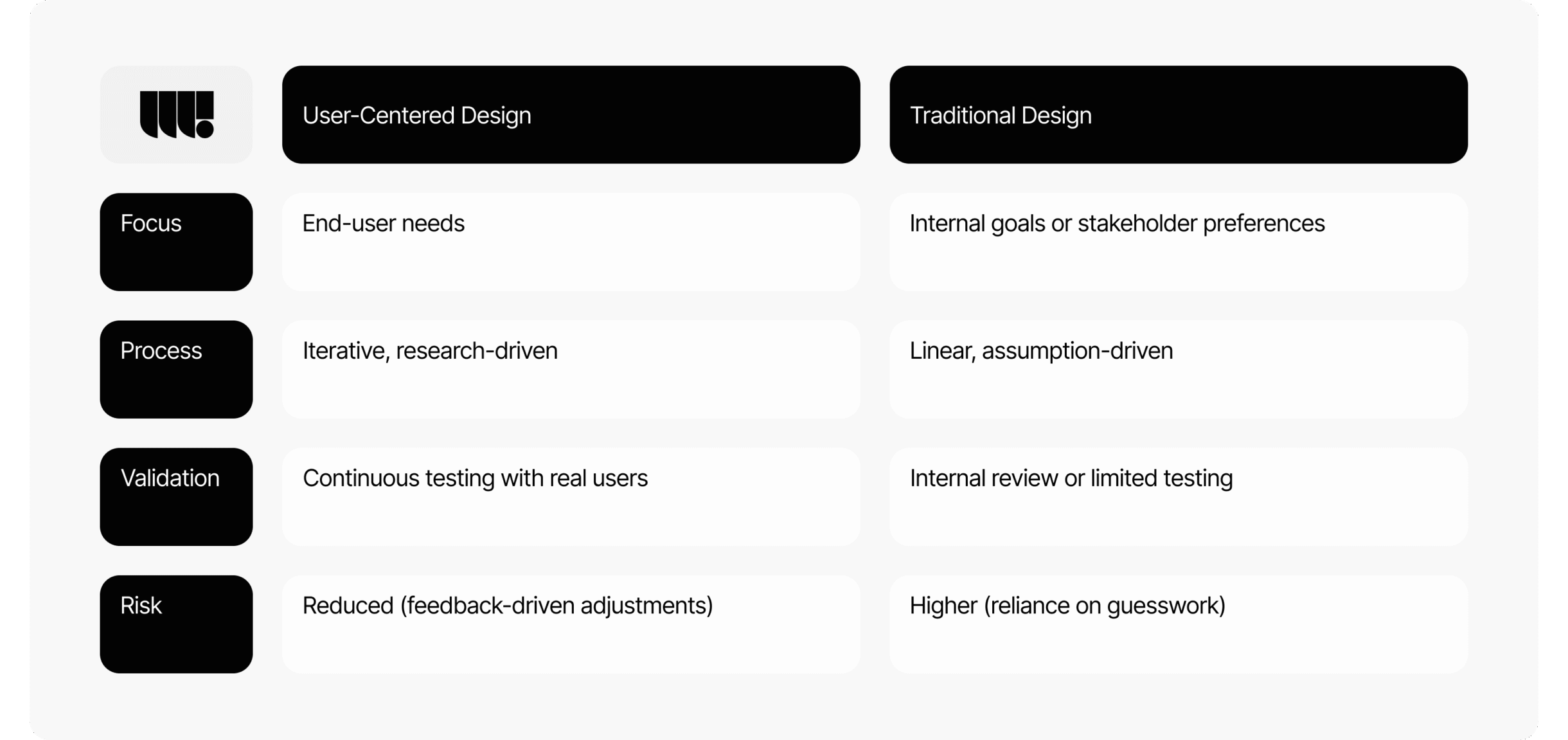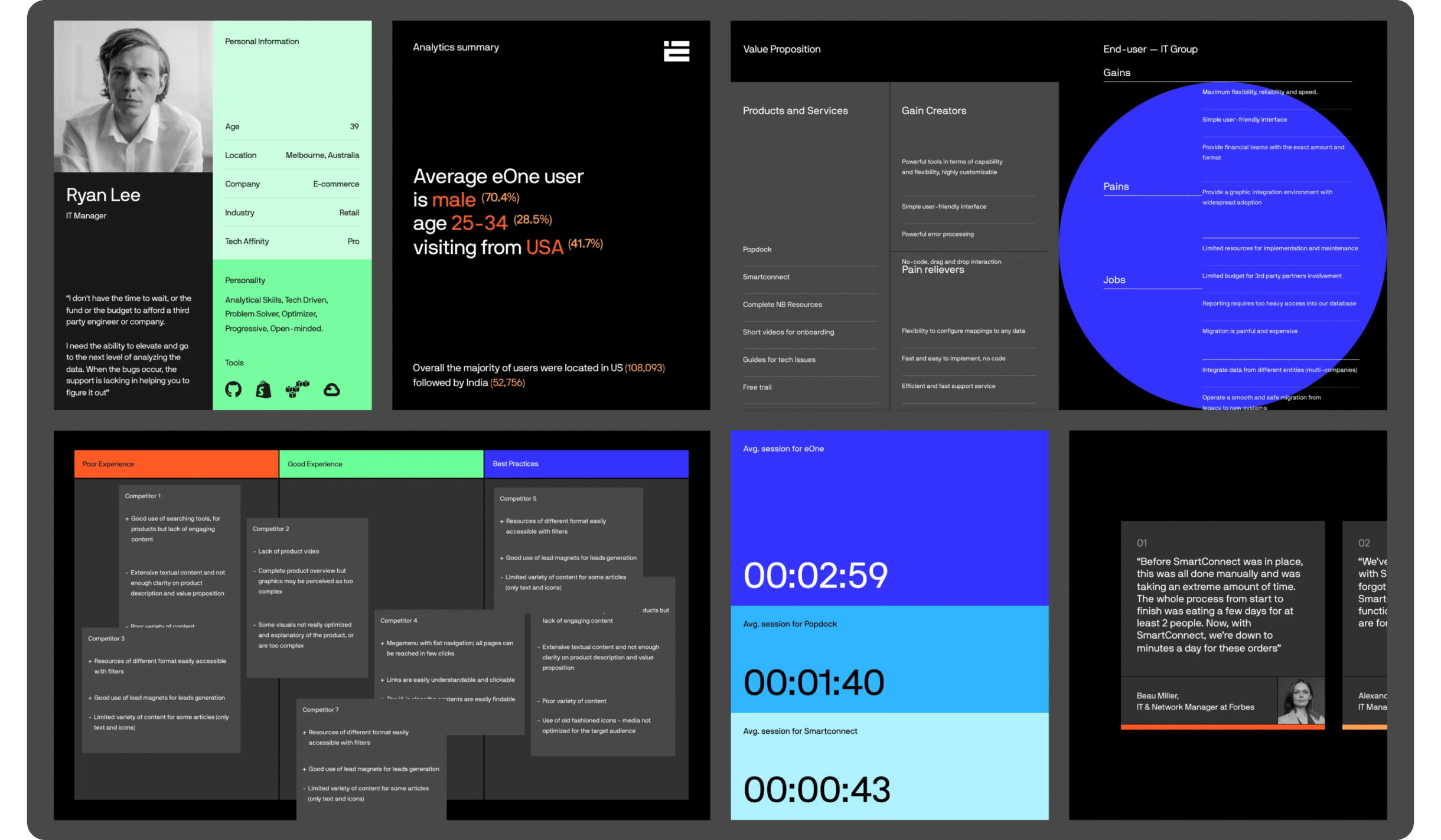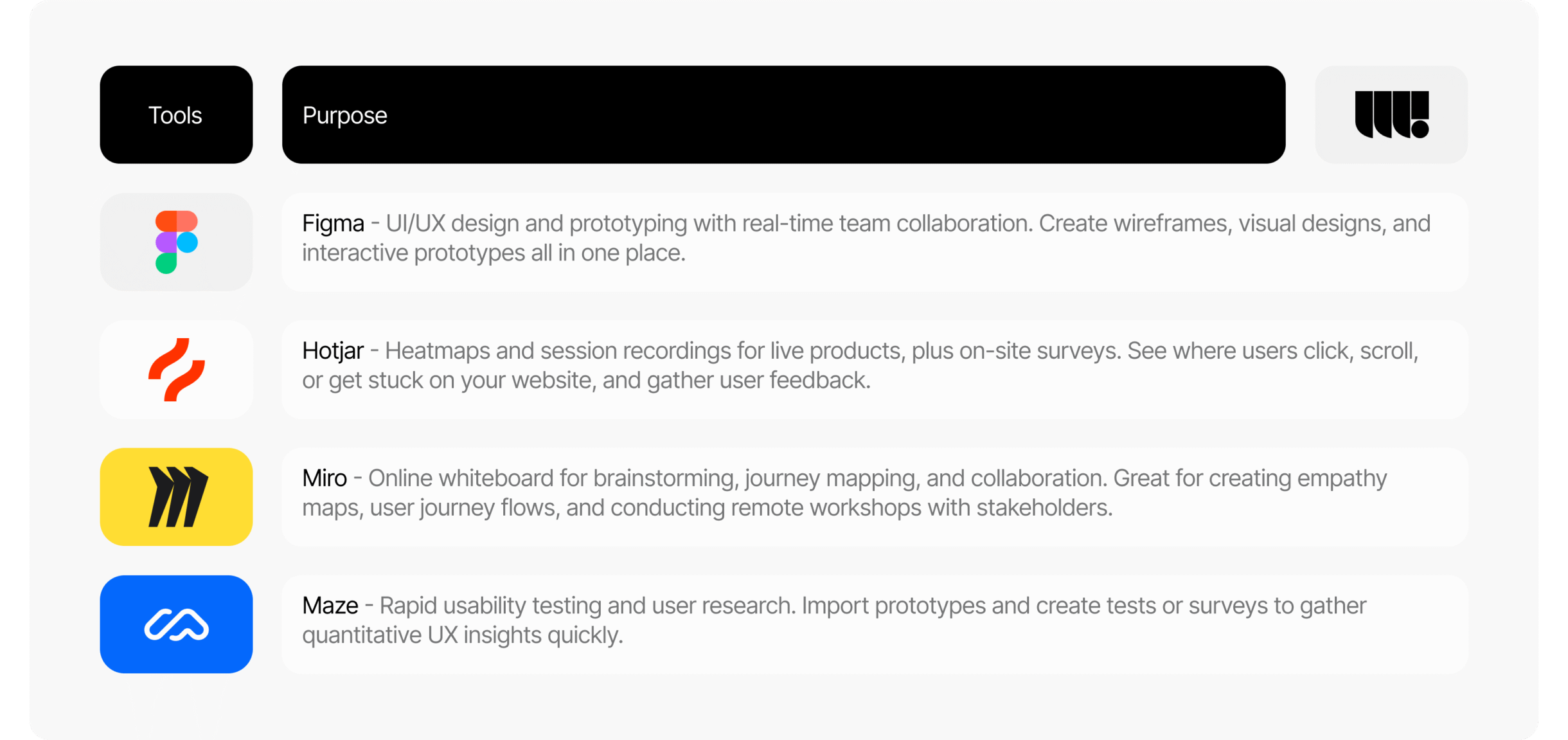Today in 2025, user-centered design is not just a nicety – it’s essential. Users have limited patience for confusing or slow experiences. (Over half of visitors will leave a website if it takes more than 3 seconds to load).
With competition only a click away, delivering digital experiences that truly resonate with target users is a critical differentiator.
Whether it’s a fintech app simplifying money transfers or a government portal streamlining public services, people expect more than basic functionality. They demand clarity at every step, ease of use, and fast interactions.
That’s why user centered design is important: it ensures digital products are intuitive, efficient, and enjoyable, directly impacting user satisfaction and business outcomes.
Adopting a user-centric design approach is not optional – it’s foundational. User-centered design (UCD) means designing based on concrete user data: understanding user behaviors, motivations, and pain points, then iterating solutions around those needs.
As a top UX research agency, we transform user insights and behavioral data into actionable strategies that drive your product’s success.
The core principles of UCD serve as foundational guidelines to keep the focus on users throughout the process.
This approach builds not only better usability but also trust, loyalty, and an emotional connection between a brand and its users. Putting users at the center of the design process ensures their needs and expectations are prioritized at every stage.
In turn, that translates into improved business performance and long-term customer relationships.
For business owners, entrepreneurs, UX/UI designers, product managers, and tech professionals, embracing a human-centered design mindset is a first step toward happier users and, ultimately, business success.
Achieving this requires a clear understanding of user behaviors, and goals to inform every design decision. In this post, we’ll walk through a step-by-step process on how to develop a user-centered design strategy to elevate your digital product’s UX design.
User centered products are the outcome of this approach, driving engagement and user satisfaction.
What is User-Centered Design?
User-centered design (UCD) is an iterative design process focused on the end-users and their needs at each phase of web development.
The key principles of user-centered design emphasize understanding users’ behaviors, needs, and contexts to inform every design decision. Instead of starting with a product idea and then forcing users to adapt, UCD begins with user research to discover what people truly need and want.
User centered design takes into account users’ natural behaviors and mental models, ensuring products are intuitive and align with how people think and act. The ultimate goal is to make the user’s experience intuitive, enjoyable, and effective.
Consult with our design experts for a free UX audit tailored to your product and audience. If our partnership isn't the right fit, we're happy to provide valuable insights that could still benefit you.
In practice, UCD involves continuously engaging real users, iterating through design cycles, focusing on the user’s context and usability, and validating ideas by testing them with users. In summary, a user-centered design strategy typically includes:
- Continuous user involvement: Engage users early and often for feedback.
- Iterative design cycles: Follow an iterative process – design, test, gather feedback, and refine repeatedly rather than in one linear pass.
- Focus on context and usability: Design for how and where users actually interact with the product, ensuring it’s easy to use and matches how users naturally behave and think.
- Validation through user testing: Evaluate prototypes and features with real users to confirm they work as intended.
By considering real user needs throughout the process, teams can avoid expensive design mistakes, foster higher user engagement, and create products with long-term value. This is the hallmark of a customer-first product strategy and integral to any strong UX design approach.
User-Centered Design vs. Traditional Design
It’s helpful to contrast a user-centered design strategy with more traditional design approaches:

Integrating UCD into the digital product development process ensures that user insights guide decisions from the earliest stages, resulting in solutions that are both effective and user-friendly.
In conventional design practices, UI/UX design teams often build digital products based on assumptions or business-driven ideas, expecting users to adjust their behavior. UCD flips that script: products are designed around the users’ reality and feedback.
UCD emphasizes understanding and defining user requirements and business requirements early in the process, ensuring alignment between what users need and what the business aims to achieve.
This user-first approach supports data-driven digital product development and is essential for any modern enterprise UI/UX design strategy.
Development teams play a key role in collaborating throughout the process to align the product’s technical requirements with both user and business needs.
Understanding User Needs
A successful user centered design strategy starts with a deep understanding of your users’ behaviors, and pain points. This foundational step ensures that every design decision is grounded in real-world insights, not assumptions.
User research is the engine that drives this process, employing a variety of research methods – such as surveys, interviews, and usability testing – to gather both qualitative and quantitative data about your target audience.
By engaging in user research, UX design teams can uncover what motivates users, where they encounter friction, and what they truly value in a product.
Usability testing, in particular, allows you to observe how users interact with your product in real time, revealing hidden obstacles and unmet needs. These insights are invaluable for developing design solutions that are not only functional but also intuitive and enjoyable to use.
Focusing on user needs through a centered design approach leads to products that feel natural and satisfying, reducing user frustration and increasing engagement. Ultimately, understanding and addressing user needs is the key to delivering a positive user experience that keeps people coming back.
User-Centered Design Principles
At the heart of user-centered design are a set of guiding principles that ensure every product is created with the user’s best interests in mind. These user-centered design principles include empathy, user involvement, and an iterative design process.
Empathy is about seeing the world through your users’ eyes, understanding their goals, challenges, and emotions. This mindset helps designers focus on real user problems rather than internal assumptions.
User involvement means actively engaging users throughout the design process, from early UX research to usability testing and feedback sessions.
This ongoing collaboration ensures that design solutions are shaped by actual user input, not just designer intuition.
The iterative design process is another core principle, emphasizing continuous improvement. Instead of aiming for a perfect solution in one go, teams create prototypes, test them with users, and refine based on feedback.
This cycle repeats until the product meets user expectations and delivers a smooth user experience.
By embracing these user-centered design principles, design teams can develop solutions that are effective, efficient, and user-friendly.
Aligning User-Centered Design with Business Objectives
For user centered design to deliver maximum business value, it must be closely aligned with your organization’s objectives.
This means ensuring that your UX design solutions also support key business goals, such as increasing conversions, boosting retention, or enhancing brand reputation.
Start by identifying the key performance indicators (KPIs) that matter most to your business. Then, use a centered design approach to develop solutions that help achieve these targets while still prioritizing a positive user experience.
For example, simplifying a checkout process can both reduce user frustration and increase sales – a win for both users and the business.
When user centered design is integrated with business objectives, the result is improved user satisfaction, stronger customer loyalty, and measurable business success.
This alignment ensures that your product is not only user centered but also strategically positioned to achieve your organization’s goals.
Steps to Build a User-Centered Design Strategy

Establishing an effective user-centered design approach requires a series of deliberate steps. Here’s how to turn theory into practice.
Throughout each step, leveraging research and design techniques is essential to ensure the process remains focused on users and results in optimal design solutions.
Conduct UX research or hire an expert UX/UI design agency to help your team perform a mix of qualitative and quantitative research methods, such as:
- Interviews: One-on-one conversations to uncover user goals and challenges they face.
- Surveys: Scalable way to gather preferences and opinions from many users.
- Usability testing: Watch users as they interact with your existing product or prototype to identify any difficulties they encounter.
- Analytics & data: Examine usage data, click paths, and drop-off points to identify trends in user behavior.
- Focus groups: Gather direct feedback from target end users to understand their needs, preferences, and behaviors.
Choosing the right research method, such as focus groups or interviews, is crucial for gathering actionable insights that inform the UI/UX design process.
User research reveals the challenges people face and why they make certain decisions. These insights are the foundation for designing a valuable product. (Pro tip: Begin with empathy. Tools like empathy maps or user diaries can help uncover the emotions and motivations driving user actions.)
Define User Personas: Based on research, create user personas – fictional profiles representing key segments of your audience. Each persona should include details such as age, occupation, goals, challenges, behaviors, and preferred tools or platforms.
Personas keep the team focused on real user needs instead of internal biases.
When everyone understands who you’re designing for (e.g., “Meet Anita, a busy 35-year-old working mother who values convenience…”), it’s easier to design with empathy and clarity. This step is crucial for customer-centric design and prevents the design team from falling back on assumption-driven decisions.
Defining the ideal user helps guide the design process to better align with users’ needs and expectations.
Map User Journeys: Develop user journey maps to visualize the end-to-end experience of users interacting with your product or service.
Consider the stages a user goes through: Awareness (How do they find out about your product?), Consideration (What motivates or discourages them along the way?), Decision (What leads them to convert or drop off?), and Retention (What keeps them coming back?).
Mapping these journeys helps you identify friction points and opportunities to improve each step.
Creating a user journey map also enables you to create user scenarios that illustrate how users interact with your product in real-life situations.
Using user scenarios helps identify user problems and address both user and task requirements.
The goal is to see your product from the user’s perspective – from the first touchpoint to the final outcome – and ensure a smooth, satisfying journey. This understanding is essential for designing experiences that improve customer loyalty.
Prototype and Test: With insights in hand, start creating prototypes – these can range from simple wireframes to high-fidelity interactive mockups. High-fidelity prototypes are especially valuable for realistic user testing and gathering detailed feedback.
Prototyping lets you visualize how the solution will work before full development. Once you have a prototype, conduct usability tests with real users.
Observe them using the design: Can they complete key tasks easily? Where do they get confused? Gather feedback and iterate on the design to address any issues. This cycle of design, test, and refine continues until the experience meets user expectations.
This iterative process ensures continuous improvement and refinement of the product.
By testing ideas early and often, you validate what works and fix what doesn’t, which is far more efficient (and cost-effective) than making changes after launch. This approach helps create highly usable products that meet users’ needs and preferences.
This iterative design process is a cornerstone of successful UX design in both startup and enterprise environments.
Benefits of User-Centered Design for Businesses
A user-centered design strategy doesn’t just make a product look nice or easier to use – it directly impacts business outcomes in many positive ways:
Increased User Satisfaction
Thoughtfully designed user experiences lead to happier customers. When a product is intuitive and solves user needs, it earns positive reviews and word-of-mouth recommendations.
Satisfied users tend to trust the product more and stick around longer, boosting loyalty. (In fact, studies show that satisfied customers are willing to spend up to 140% more and recommend the company to others).
High satisfaction is the cornerstone of a customer-first strategy. Measuring user attitudes, such as happiness and satisfaction, using frameworks like Google HEART, is essential for evaluating overall UX success.
Lower Web Development Costs
Investing in user-centered design early on can save significant costs later in the process. On average, an experienced web agency may charge anywhere between $100 and $300 CAD per hour for development. By identifying usability issues during the research and prototyping stages, you can avoid expensive rework and fixes after development.
Changes made before or during design are much cheaper than changes made post-launch – fixing a problem after a product is released can cost 10× to 100× more than fixing it during the design phase. In short, UCD promotes a leaner, more efficient development process by doing things right the first time.
Higher Conversion Rates
A user-centered design removes friction in user flows, making it easier for visitors to become customers. Simplifying navigation, clarifying content, and streamlining steps can dramatically improve conversion.
Forrester Research has noted that a well-designed user interface can boost website conversion rates by up to 200%.
Businesses that focus on UX can turn more of their traffic into tangible results – whether that’s sign-ups, purchases, or other key actions – thanks to a smoother journey.
UCD also helps ensure users engage more effectively with the product by addressing their tasks.
Stronger Brand Loyalty
Great UX builds an emotional connection with users. When people have positive experiences, they’re more likely to return and become repeat customers. They also develop trust in your brand, increase brand awareness, and may even become advocates, referring others to your business.
Conversely, a single bad experience can quickly erode loyalty – one survey found 32% of consumers will walk away from a brand they love after just one negative experience.
By consistently delivering a user-centered experience, you boost retention and protect your reputation.
Competitive Advantage
In saturated markets, user experience can be a key differentiator. If you deeply understand user behavior, you can develop unique features or services that competitors haven’t thought of, addressing pain points others ignored.
Products that truly fit into the user’s life stand out. Companies known for their user-centric approach (like Apple or Airbnb) often set the bar in their industries. By prioritizing UCD, you strengthen your position against competitors who are slower to adopt a user-first mindset.
Tools to Implement User-Centered Design
Building a user-centered design doesn’t happen in a vacuum – there are many UX research tools that can help your team research, design, and test with users more effectively. Here are some popular tools (and what they’re useful for) at various stages of the UCD process:

Conclusion
Developing a user-centered design strategy isn’t a trendy buzzword. Startups and global corporations alike have found that organizations embracing user-centered (or human-centered) design and design thinking consistently outperform those that don’t.
In fact, companies that successfully integrate design and user feedback into product development achieve significantly higher returns – study found a 56% higher total return to shareholders compared to industry benchmarks for such companies.
To recap, a solid user-centered design strategy typically involves four key steps:
Conducting in-depth user research;
Creating realistic user personas;
Mapping out detailed user journeys and
Iterative prototyping and testing of solutions.
By following this process, UX teams ensure that every design decision keeps the end user in focus.
The payoff for this approach is substantial: better user experiences, increased customer satisfaction and loyalty, lower churn, and ultimately, business growth. User-centered design leads to products that people love to use.
If you’re not sure where to begin, start by shifting your mindset – design for your users, not for yourself. By doing so, you’ll align your product with genuine user needs and set the stage for digital products that thrive.












